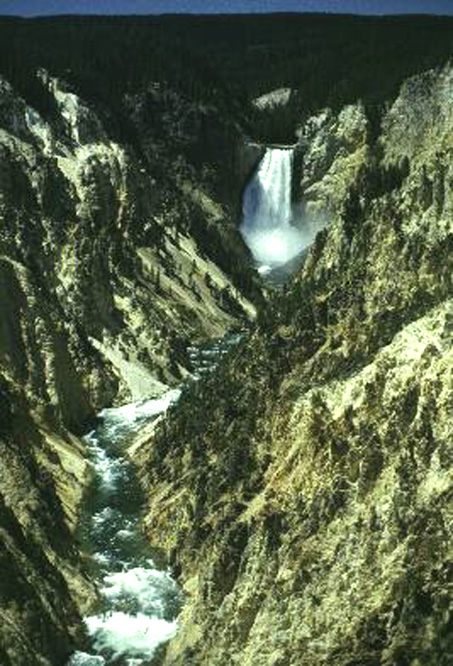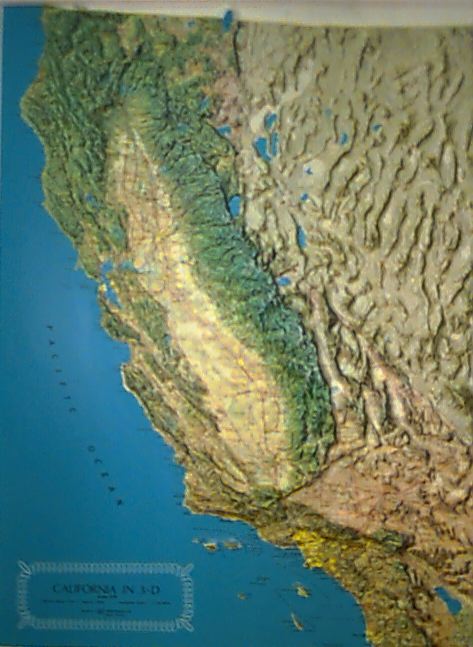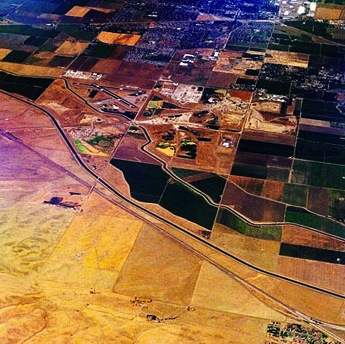
Nash, Wilderness and the American Mind, pp. 141-199.
"To sin by their silence makes cowards of men."
Abraham Lincoln.
Who was John Muir and what were
his arguments for the values he felt were inherent in wild areas?
The "Grand Canyon" of the Yellowstone River, Wyoming.
"The world's first instance of large scale wilderness preservation in the public interest occurred on March 1, 1872 ...designating over two million acres of northwest Wyoming as Yellowstone National Park."
In 1885, " the State of New York established a 715,000 acre 'Forest Preserve' in Adirondacks with the stipulation that it 'shall be kept forever as wild forest lands'. With these milestones in the early history of American wilderness preservation, the ideas of Catlin, Thoreau, Hammond and Marsh bore fruit."
108

Ms. Dearmas [Rollins Alumna], photograph of an Adirondack stream, New York state.
"...the necessity of forested land for adequate water supply."
p. 108.
"The aim of the law was the preservation of wilderness, but for commercial ends."
p. 119.
In 1894 the protection was made part of the state Constitution.
p. 121.
Terms and people to know:
Water -- "the watershed argument"
"By the 1880s, evidence of declining water levels in the Erie Canal and the Hudson River generated widespread concern. An intensive campaign began began in the fall of 1883 with the New York Tribune contending ..."seeing that it [Adirondack Mountains] contains the fountainheads of the noble streams that conserve our physical and commercial prosperity."
pp. 118-119.
"Wild country needed a champion, an in...John Muir it found one."
"For John Muir Transcendentalism was always an essential philosophy for interpreting the value of wilderness."
"natural objects were terrestrial manifestations of God."
p.125.
He fought to protect the Sierra Nevada Mountain Canyon called "Hetch Hetchy Valley" a deeply carved glacial scar whose water was coveted by the City of San Francisco, recovering from the devastating earthquake of 1905.
"Of the Sierra wilderness as a whole Muir exulted...–one smooth pure, wild glow of Heaven's love."
p. 125-26.
"Muir's ideas developed as a result of observing the stifling effect on man's spirit of 'the galling harness of civilization. Civilized man chokes his soul..." John Muir, 1871.
p. 127-28.
He "...coincided with the advent of national concern over conservation."
March 3, 1891 Forest Reserve Act passed Congress
"withdrawing land from the public domain..."
p. 133.
By the summer of 1897 "he realized that under the forester's control they held little promise for the preservation of wilderness."
p. 138.
Camped with President Theodore Roosevelt in Yosemite Valley, in 1903.
pp. 138-39.
Yellowstone, Grand Canyon of (1872)
Yosemite Valley (1864)
Hetch Hetchy Valley
Not unlike Yosemite Valley, its sister, Hetch Hetchy was a glacially carved, steeply etched in granite, secluded and rock-walled setting.
The number of sides to the argument over Hetch Hetchy Valley:
1. private power, Pacific Gas & Electric Co. (PG&E), hydroelectricity power
2. public power, City of San Francisco , municipal water & power.
3. scenic preservation, Sierra Club protect both valleys from flooding.

A clash of Values that continues to this very day:
- Survival
- Esthetic
- Commercial
- Sacred
- Utilitarianism
- Water supply and Flood control
- Scenic monumentality
- Recreation
- Cultural landscape
- governmental interagency rivalry
A split in federal agencies
The Great Central Valley, & California Aqueduct, 2004.

Department of Interior, 1849 (USDI)
Bureau of Reclamation in the USDI (1902)
Army Corps of Engineers (1802)
National Forests and the USDA (Agriculture, 1864) [moved in 1905]
National Parks in the USDI (1916)
Bureau of Land Management (1946)
Civilization had largely subdued the continent. Labor saving agricultural machinery and a burgeoning industry, coupled with a surge in population, turned the american focus from country to city....the frontier was moribund, wilderness no longer dominant."
p. 143.
Urbanization vs. agrarian values
"... go to the wilderness" George Evans
Joe Knowles, August 10, 1913, he entered the Maine Woods naked to live alone for sixty days.
He clubbed a bear to death and was the "talk" of eastern newspapers from Boston to Kansas City.
"apparently wanted to believe in the authenticity of 'Nature Man'."
pp. 141-142.
Progressives versus traditionalists sparred over the nation's future direction.
Aldo Leopold
"San Francisco faced a chronic fresh-water shortage. In the Sierra about one hundred and fifty miles distant, the erosive action of glaciers and the Tuolumne River scooped out a spectacular, high walled Hetch Hetchy valley."
p. 161.
1876
1891
June 4, 1892
1901
April 18, 1906
What does Nash mean by these arguments?1910
1913
“…Americans of the late nineteenth century realized that many of the forces which shaped their national character were disappearing.”
p. 145.
“Civilization has so cluttered this elemental man-earth relation with gadgets and middlemen, that awareness of it is growing dim. We fancy that industry supports us, forgetting what supports industry.”
p. 199.
“All history consists of successive excursions from a single starting point, to which man returns again and again to organize yet another search for a durable set of values….raw wilderness.”
Ibid.
The art of consumer waste:
"The collective is made up of just lots and lots of individual consumers."